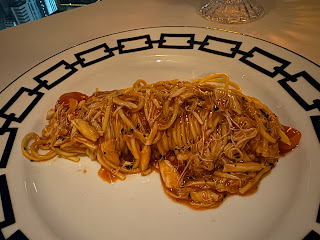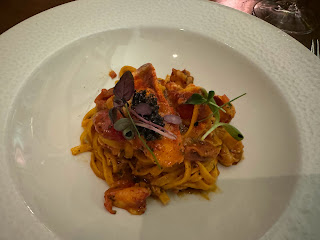Greeted warmly at the entrance, the staff took us through the casual dining space on the ground floor to the elevator. The restaurant is located on the first floor, with a theme of the ocean showing plenty of turquoise colour, and hanging decorations reminded us of swimming fish. We were seated comfortably at a circular banquette looking at the open kitchen with the team busy in action.
There were three menus and we opted for the 8-course Alta Marea ($2,488 each), which means High Tide in Latin, with also wine pairing available ($1,388). The first wine paired was Champagne Pertois-Lebrun L’Extravertie Grand Cru Blanc de Blancs NV. A crisp and expressive champagne made using biodynamics method, it has nice citrus, floral and green apple aromas, refreshing and lively.
There were four canapes in the Amuse Bouche. The first one featured Razor Clam, with the thinly-sliced clam arranged to look like flower petals on potato slices, with an almond pesto and a black truffle flower on top. The second was Crispy Squid Ink Cone, stuffed with black garlic and artichoke puree, with a bit of Ossetra caviar. The third one featured a Raw Tuna Cube, which had been dipped in hibiscus and nori tea, then wrapped in shiso leaf, with the shaving of dried tuna heart and burnt lemon gel to season. The fourth piece was Morel Tart, with the mushroom coming from Yunnan, glazed with honey, and together with caramelized shallot on cocoa crispy dough, cooked like tarte tatin. A great array of flavours and texture. Very good.
Then the staff brought a large ‘wood stump’, with a hollow holding the Bread, with its recipe from Chef Colagreco’s grandmother, and very much the roots of what got him inspired to be a chef. He wanted us to experience sharing the bread, like what he did with his family in the old days, gathering in his grandmother’s house on each Sunday. There was also a poem on the side, his favourite poet from Chile, which talked about sharing breads. To pair with the bread was an olive oil from Menton, which had been infused with seaweed. Very good.
The second wine paired was Sigalas Santorini Assyrtiko 2022. The wine has a refreshing palate, showing some grassy, citrus and stone fruit characters, with nice minerality and crispy acidity, and some floral notes in the background. Its minerality and saline-forward note is a good match with seafood, particularly raw oysters. Perfect pairing.
The first course was Oyster. The French raw oyster was cut into small pieces, with some diced kiwi underneath. On top there was a layer of foam, which was made from cucumber, tonka beans, cream and shallots. Rich and flavourful. Making up the topmost is the carpaccio of cucumber, neatly organized to cover the whole surface, with some edible flowers to decorate. Dusted with shavings of tonka beans to give a bit of its unique aromas, it is a wonderful starter. Very good.
The third wine paired was Radikon Sivi, from the famous orange wine producer in Italy. Made from Pinot Grigio, the must had been macerated with skin for 10-12 days. There was some red fruit aromas and earthiness in the wine, which matched beautifully with the beetroot in the subsequent course. Another perfect pairing.
The second course was Beetroot and Caviar. A signature dish of Chef Colagreco, the beetroot, coming from China, had been baked in salt crust to remove the earthy flavours while keeping its sweetness. Cut into slices with a soft bite, the chef had prepared a cream sauce with caviar, adding a creamy texture and umami taste to the beetroot. In fact, the caviar was from a famous French producer called Huso, each one glistering and very large in size. Excellent.
The fourth wine paired was Domaine du Pelican Arbois Poulsard 2018. The Jura red wine was made of the local grape variety Poulsard, with a sweet strawberry, cherries and prune, some hints of smokiness, and nice earthy tones. Yet another good choice of wine for matching with the fungus to come.
The third course was Sparassia Crispa, a type of fungus with another common name of cauliflower fungus. Coming from China, the fungus was special in the way that it did not need to be trimmed post-harvest. Cooked by wrapping in foil, or papillote, with herbs and butter inside, it had retained its great natural taste, with a bit of smokiness from the torching at the top. Underneath was some raw hijiki seaweed salad, seasoned with tarragon and dill, with some pomegranate seeds for its acidity. The sauce was made from the jus of the fungus with cream. Fantastic flavours and texture. Excellent.
The fifth wine paired was Domaine de Cristia Chateauneuf-du-Pape Blanc 2021. From a blend of 60% Clairette and 40% Rousanne, the wine had decent acidity, demonstrating nice floral characters. with medium body, its creamy and vanilla aromas were highly complementary with the buttery sauce of the next course, with everything in good balance.
The fourth course was Scallop and Black Truffle. The Hokkaido scallop was cooked in truffle butter before cutting into bite sizes, with garlic puree underneath. On top of the scallops was a mousse made from Jerusalem artichoke, offering a bit of bitterness, with a bouquet of black truffle from Périgord in France. Sprinkled with some black lime from Iran, the sauce was a combination of scallops and vanilla. Complex in flavours and delicious. Very good.
The sixth wine paired was another Jura, of the same producer Domaine du Pelican, but this one is the white Arbois, Savagnin Ouille 2018. The rich and expressive Savagnin had good minerality, with a bit of peach and nutty characters. Refreshing and not to be confused with the traditional yellow wine vin jaune.
The fifth course was Brittany Blue Lobster. On the base was pumpkin sauce and pumpkin puree, which had been cooked with orange reduction, together with some morels. In the middle, apart from the delicate and sweet blue lobster meat, were the diced Japanese citrus to give some refreshing acid. On the top was carpaccio of the pumpkin, beautifully presented. The sweetness of the pumpkin and the acidity of the orange reduction and Japanese citrus created the perfect balance, and the texture of the pumpkin slices with the puree was an interesting contrast. Very good.
The seventh wine paired was Arnaud Baillot Meursault 2021. From the rich honey aromas on the first sniff, the constant floral notes of linden and hawthorn were accompanied by nice minerality, but not the usual more buttery characters for a Meursault. The higher acidity gave a more refreshing palate to go with the fish. Another wonderful pairing.
There were three options for the sixth course, with both of us choosing Wild Dover Sole from Brittany. The fish had been pan-seared on bone, before finishing in oven. The garnish was the poppy and sweet green peas, which had been added with caviar and fennel. The sauce was made from fennel extraction, infused with chamomile. There was a hint of bitterness from the edible flowers, and it would be good just to remove them. Despite that, it was still very good.
The seventh course was Sake Lees. In this creative pre-dessert, the lees of sake were used to make a cream to add to the slow-cooked cactus grown locally in Hong Kong., with also a sorbet made from cactus and Yunnan chili pepper. Topped with a crispy seaweed together with a sauce made from the extraction of green grapes, green apple, and ginger. There was a lot of flavours, with also a well-balanced combination of herbaceous, spiciness, and sweetness. Excellent.
The eighth and last wine paired was Philippe Foreau Domaine du Clos Naudin Vouvray Demi Sec 2016. This Chenin Blanc was only half dry, with good acidity to balance and freshen up the palate, showing nice honey, and tropical fruit characters. But a bit too dry perhaps for the dessert.
The eighth course was Dark Chocolate & Thyme. Underneath was the thyme ice-cream with white chocolate garnish, and sitting on top, a caramel and dark chocolate truffle, with the sorbet wrapping it, along with some nice, flower-shaped dark chocolate crisp on the side. With the different components not too sweet, it felt good and healthy, with the delicate note of the herbs permeating on the palate. Very good.
Wrapping up was the Petits Fours, which were put neatly inside a wooden box, specifically designed for Chef Colagreco’s restaurants. Opened to reveal five different desserts, including Dolce de Leche Pod with hazelnut cream and Bailey’s ice-cream, Dark Chocolate Cigar with coffee cream and cocoa powder, Macaron made from verbena, Lily Bulb with a mochi-like texture, on shiso leaf with ice plant, and Brown Sugar Madeleine with lemon zest. Finishing with a cup of Double Espresso ($82), it was a perfect finale for a wonderful meal. Very good.
The service of this restaurant was excellent, with the staff all very friendly, knowledgeable on the food and wine, and eager to share. The whole dining experience was exceptional, with a pleasant ambience, the food delicious and the wine pairing impeccable. The bill on the night was $7,133. Overall comment: Excellent.


























































